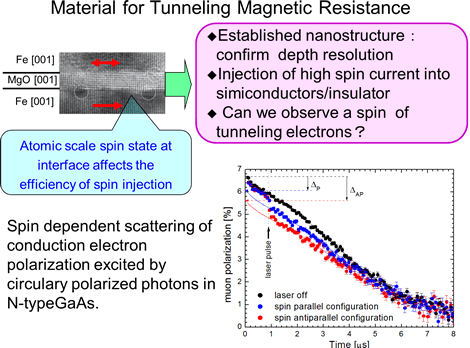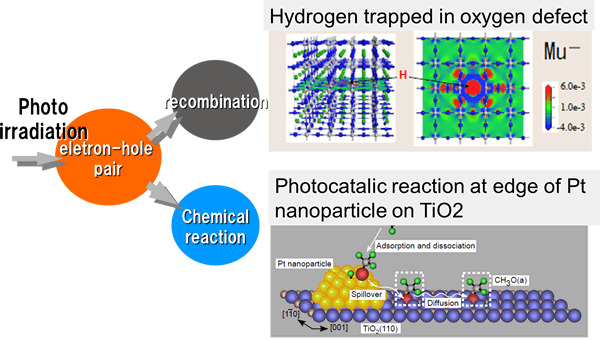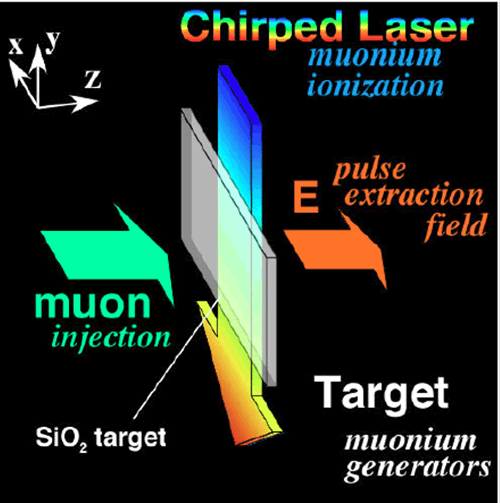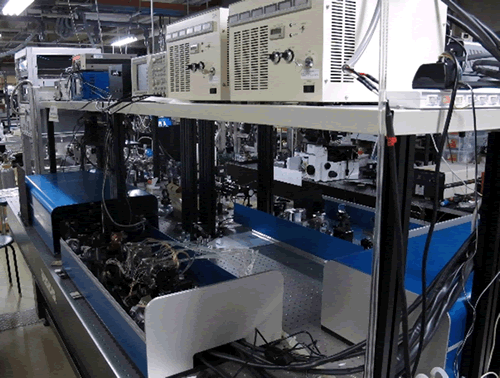

Microscopic features of transport phenomena of spins, ions, electrons and holes are essential to understand fundamental function in materials and life science. Local structure containing interfaces and boundaries is of great importance to promote or suppress transport properties. High sensitivities of spin polarized muons to various aspects of transport properties have been verified by pioneering works of researchers in this team utilizing muon as an active probe which interact with electrons and nucleus in host materials: i.e. spin current in semiconductors, ion diffusion in battery materials, electron transfer in biomolecules, and electric potential of electrons in defects of semiconductors and oxides compounds.
A muon takes either a diamagnetic (μ +) state, a hydrogen-like state with a bound electron so called muonium(μ +e-), and/or a negative muonium state with two bound electrons(μ +e- e-) depending on electron density of state(DOS) of materials. Therefore, electron binding and ionization processes of muons have potential to provide abundant information associated with spatial distribution and dynamical fluctuation of DOS which is key parameters to understand mechanism of chemical and biological reactions.
Ultra slow muon microscope, USMM, realized by ultra slow muon and muon micro beam enables us to explore local information of materials with spatial resolutions of either nanometer in depth profiling in the vicinity of surface or micrometer in three-dimensional mapping inside materials. In this team, local and microscopic transport properties as well as behavior of hydrogen in the following typical model systems will be investigated from the aspect of physics, chemistry and biology for the first time;
(1) Spin current across interfaces (Torikai, Yoshino, Nagamine, Shimomura, Higemoto, Ito, Maekawa, Kasai, Nakanishi)
In development of spintronics materials, monitoring of spin current in semiconductors is the central subjects to be studied. Conduction electron polarization excited by circularly polarized photons in n-type GaAs is clearly detected, verifying the high sensitivity of the muonium spin exchange method on the basis of Pauli’s exclusion principle. Ultra slow muon combined with this method becomes powerful tool to reveal local as well as microscopic features of spin current with detailed information on spin life time, spin diffusion length and spin scattering cross section across interfaces regardless of method of spin injection. Another important subject is to study spin density of states at interface which affects efficiency of spin injection significantly. It is also planned to observe electron spin tunneling in a thin insulating layer.

(2) Catalytic reactions on surfaces (Asakura, Ariga, Shimomura, Tsuneyuki, Nakanishi, Fukutani, Torikai)
Hydrogenation catalysts are commonly used catalysts in many fields. Hydrogen dynamics not only on surface but also near surface region is playing important role for the reaction. As hydrogen is one of the most difficult elements to be detected, chemistry of hydrogenation catalytic reactions has not been fully understood.
Photocatalytic reaction is activated by electron-hole pair generation by photo-irradiation on an oxide surface. Understanding and controlling oxygen vacancy defects are on one of the key issues for developing highly efficient photocatalysts. Because oxygen vacancy defects become a charge trapping site, which promote the charge transfer to reactants and enhance reaction when it exists near the surface, while they suppress the reaction as a recombination center of electron and hole when it exists far from the surface.

(3) Ion-diffusion in solid state batteries (Sugiyama, Nozaki, Harada, Kanno)
The interface between electrode and electrolyte is the key to control ion-diffusion in solid state batteries. μSR provides information on diffusion of Li and Na ions in battery materials. Ultra slow muon and micro beam, thus, clarify the depth profile of the diffusive nature, particularly at the hidden interface between cathode and electrolyte. USMM gives crucial information how to make a suitable interface between electrode and electrolyte, leading to an advanced solid state battery.

(4) Electron transfer in biological system (Nagamine, Sugawara, Shimomura, Higemoto, Torikai)
Electron transfer plays an important role in the biological system, such as photosynthesis and respiration in proteins and self-repairing from damage of DNA.
A labeled electron method using positive muons has revealed, in the case of cytochrome c and DNA, predominant one-dimensional nature of electron transfer along intra-molecular chain, and subsequent inter-molecular diffusion which strongly depend on hydration water contents.
Ultra slow muon provides a unique tool to study depth-resolved electron transfer phenomena at cell membrane and monitor distribution of hydration water in organisms.
Furthermore, by applying micro beam to examine anisotropic effects of ordered states, new aspects of the inter-molecular nature such as geometrical path of electron transfer will be explored.






